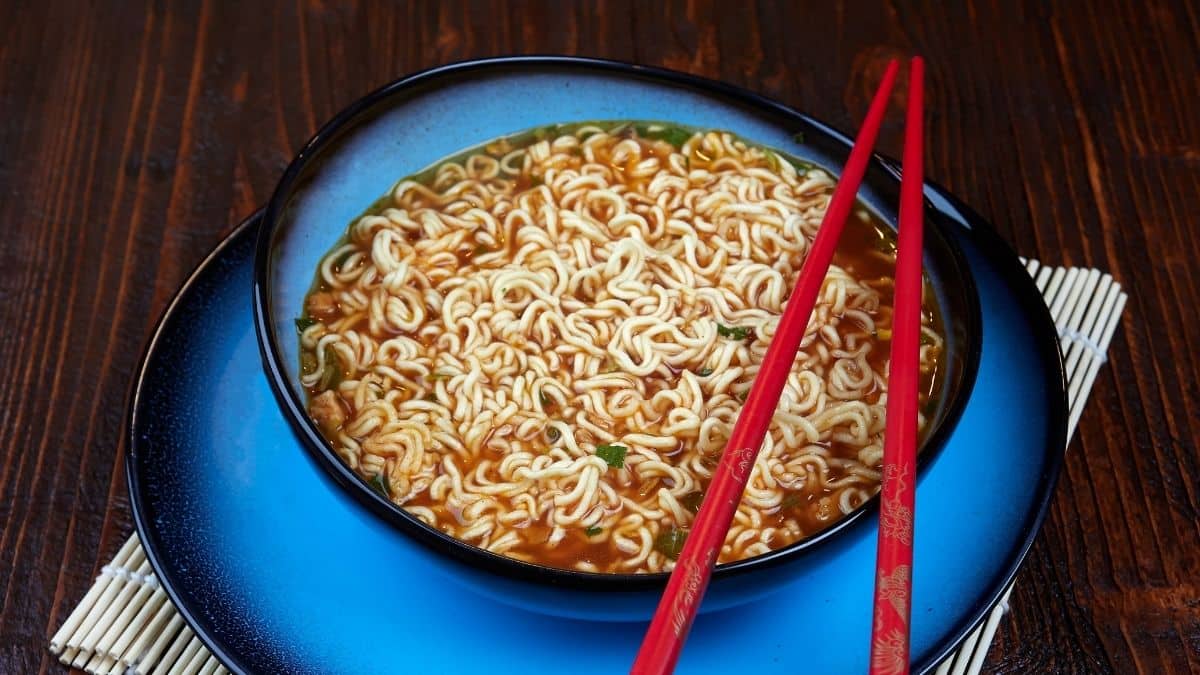Answer: Yes. Shin Ramen has two vegan choices, Spicy Veggie Ramen and Kimchi Flavor Ramen.

Is Shin Ramen Vegan?
While surfing the net, I came across a scene where the Korean characters were eating a bowl of steamy Ramyun. It made me curious about the taste and pushed me to check out what was available in the grocery. As I passed through the noodle shelf, I am faced with many selections of Shin Ramen noodles in different flavors and wondered if my vegan diet will accept this.
When you read the ingredients carefully, it’s easy to pass the Shin Ramen as a vegan dish because of no visible meat product. It has a long list of plant-based ingredients.
About Shin Ramen
Shin Ramyun is a known global Korean brand introduced in 1986. The Korean word Shin or Sin comes from the Chinese character meaning spicy. Ramyun or Ramyeon in English is ramen which means instant noodles. The instant noodle and soup powder are prepared with boiling water and ready to eat in a few minutes.
Upon close inspection of the ramen pack, you will see the different materials used for Shin Ramen. The dried ramen noodles made of wheat flour, potato or wheat starches, vegetable oil, emulsifier, soy sauce, green tea extract, salt, and mineral salts are all plant-based. So far, there are no red flags that show any animal ingredients.
The soup powder gives a flavorful spice when mixed with hot water. The listed ingredients have hydrolyzed vegetable protein made of soy and corn, maltodextrin, made from vegetable starch, soybean, cornflour, and wheat flour.
Ways to Prepare Shin Ramen
Enjoying a hot bowl of Shin Ramen is an easy process in a short time. There are different ways to prepare your ramen bowl. To get the correct consistency of the noodle, you must follow the right time for each process.
Traditional Way of Boiling Water
The traditional way to prepare Shin Ramen is to boil 2 ⅓ cups of water. Drop in the noodles, the soup powder, and the vegetable mix. Cook for five minutes stirring the noodles a bit – your ramen will be at a piping hot temperature.
The cooked noodles have a nice sheen appearance once it’s come to a boil. It has a distinct snap when you start to chew while savoring the spicy broth.
Steeping the Shin Ramen
Place your soup powder, vegetable mix, and noodles in a bowl. Boil 2 cups of water and add into the bowl with a lid. Let it steep for seven minutes, then mix all ingredients. The ramen that you will eat is at a tepid temperature and not piping hot.
The noodles have different textures depending on how much you mix while steeping. Some are soggy noodles, while others are crunchy if left unsoaked.
Microwave the Shin Ramen
Put the soup powder and vegetable mix in a microwave bowl, then add the noodles on top. Add two cups of water at room temperature. Place a lid on the bowl and microwave the ramen soup for seven minutes.
The noodles came out unevenly cooked with the absence of not being able to stir while boiling. The ones under the bowl were bloated.
Is Shin Ramen Healthy?
Nothing beats a freshly made bowl of soup from scratch. You do away with preservatives and flavorings that are chemically enhanced. But preparing soup takes time and requires a lineup of different spices to achieve a similar Shin Ramen taste.
All instant foods have a drying process and added preservatives to keep them longer on the grocery shelves. It is edible and not harmful if taken in moderation or spaced apart. Instant noodle soups such as Shin Ramen fall in the same category.
While Shin Ramyun is popular for its bold flavor, it’s important to note that it’s not the healthiest option due to its high calorie content from both carbs and fats. Additionally, it contains additives like monosodium glutamate (MSG) and tertiary butyl hydroquinone (TBHQ), which have raised some health concerns. For those seeking vegan-friendly instant noodles, Shin Ramyun offers a flavorful choice, but understanding these ingredients helps you make informed decisions and manage your consumption wisely in 2025.
Deconstructing Shin Ramen
Shin Ramen is a noodle soup that can satisfy your instant hunger craving and warmth in the belly. But there are ways to deconstruct the regular instant noodle into different dishes to add a twist to the pack.
Minestrone Shin Ramen
Boil the Shin Ramen except for the vegetable mix. Replace it with real chopped vegetables like squash, zucchini, green beans, peas, and potatoes. Your ramen has nutritious vegetables that will give you added vitamin content and fiber.
Asian Vegetable Shin Ramen
Boil the Shin Ramen, then add shiitake mushrooms, broccoli, edamame, mushrooms, cabbage, and carrots. Just like the minestrone, when you add fresh vegetables to your soup base, you feed your body with added vitamins and fiber.
Ketchup Shin Ramen
Boil the Shin Ramen, then add one tablespoon of Ketchup. This little detail will give a sweet and tart taste to your spicy noodle soup. It provides an added boost of proteins, sodium, carbohydrates, and an added dash of lycopene to your soup.
Soy Milk Shin Ramen
Cook the ramen noodles, then drain the water. Boil in 1.5 cups of soy milk and add the soup powder and the vegetable mix. The milk will give the soup a savory and creamy texture, similar to the Japanese miso soup. This will add protein to your soup because of its soy content.
Tomato Shin Ramen
Boil 2.5 cups of water with ½ fresh tomato and ¼ sliced onion, then add the soup powder. Mash the tomato and onions and add the noodles. Add one teaspoon of vinegar, then serve. The tomato ingredient gives an extra boost of lycopene and an antioxidant component to your noodle soup.
Stir-Fry Shin Ramen
Boil the ramen noodles, then drain. In a wok, fry onions, cabbage, and carrots using the soup powder to flavor the chopped vegetables. Add some water and the boiled noodles and toss everything together. Top off with sesame oil. This changes the soup into a dry noodle-based viand.
Cold Shin Ramen Salad
Boil noodles and drain the water. Mix the chopped cucumber, cabbage, green onion, and chili pepper with the soup powder. Add 1.5 tablespoons of sugar, 1.5 tablespoons of white wine vinegar, 1.5 tablespoons of soy sauce, and 1 cup of iced water. Pour the mixture over the noodles and sprinkle almond seeds for your salad.
Asian Noodle Salad
Break the dried ramen noodles into chunks and mix them into the coleslaw of cabbage, cucumber, and green onions. Mix in the dressing of rice wine vinegar, sesame oil, and sugar. Chill in the fridge for an hour, then top off with soup powder and sesame seeds.
Creative Vegan Ramen Snacks
There are ways of using ramen without soup powder as a creative vegan snack. You can use the soup powder as an added spice. The ramen noodles have a distinct texture that makes them easy to use with other ingredients.
Ramen Trail Mix
Cut the dried noodle into squares and mix them with the usual trail mix combination of pretzels, cereals, peanuts, and raisins. Sprinkle it with curry powder, cayenne pepper, and salt according to taste.
Chocolate Ramen Cluster
Break the noodles into large chunks. Cut up some vegan chocolate bars and heat them in the microwave for 30 seconds until melted. Mix in the ramen chunks and cool in the fridge. This is an odd yet unique combination of salty and sweet chocolate clusters.
Chili Ramen
Boil the ramen noodles. Cook a canned vegan chili, then top it off with green onions for a chili ramen dish. The noodle and chili give an interesting texture to the crunchy noodle with the soft chili beans.
Satay Ramen
Boil the ramen, then add the peanut butter until the noodles are coated with peanut butter. Mix in the soy sauce and a squeeze of lime. This Thai-inspired dish is simple yet perfect for a quick snack packed with protein from peanut butter.
Shin Ramen & Potato Mojos
Slice potatoes soak them in water for 30 minutes, then deep fry adding the crushed ramen noodles. Coat the potato and noodles with the soup powder like preparing mojos for the spicy seasoning.
Caveat on Shin Ramen
Shin Ramen has plant-based ingredients, but there are some aspects that a vegan must be aware of when purchasing this product.
Production Cross-Contact Notice
Nongshim, the company behind Shin Ramen, warns the consumer of possible allergies since products come from the same production plant. There may be cross-contact incidences with eggs, fish, crustaceans, and milk during food preparation.
Cross-contact of animal powder ingredients is non-conclusive on the production flow of the plant. There is no documentary on how the company makes Shin Ramen. But the notice to the consumer benefits those who have food allergies.
Shin Ramen Black Beef Flavoring
Shin Ramen Black has a more intense flavor than regular Shin Ramen. In the package, it has an extra separate packet of beef stock soup. The stock is from beef bone stock, beef extract, and beef tallow. You can set aside the beef powder if you are looking for an intense flavor.
It’s best to take note of this to avoid accidentally picking up the black packaging. As long as you keep this in mind, you will be safe to stick to the regular ramen flavor. Better yet, choose the two vegan flavors of Spicy Veggie Ramen and Kimchi Flavor Ramen.
Natural Flavors
Some vegans point out the vague description of the ingredients. Flavor enhancers, thickeners, emulsifiers, and natural flavors have a variety of meanings. Under these headings, you can find dextrose derived from animal tissues and fluids. Disodium is a flavor enhancer from animals. Riboflavin may contain milk.
You can avoid falling into this trap if you can decipher what the ingredients are and ease your mind. Just exercise caution and care when you choose your ramen, knowing what to look for.




